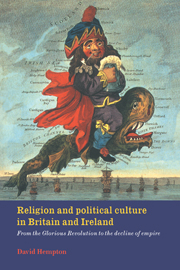 Religion and Political Culture in Britain and Ireland
Religion and Political Culture in Britain and Ireland Published online by Cambridge University Press: 06 January 2010
The same processes of rapid social change and the growth of evangelical religion that transformed the religious landscape in England in the eighteenth and nineteenth centuries made an even more dramatic impact on the religious history of Scotland and Wales. Indeed, so profound was the impact of religious change in this period that it helped shape the cultural and national identities of both countries. The aim of this chapter is to explore the complex relationship between evangelical enthusiasm and national identity by investigating the rise of Nonconformist Liberalism in Wales and the attempts to realise the historic ideal of the godly commonwealth in Scotland. In each country evangelical enthusiasm contributed both to the expression of national distinctiveness and to a shared British Protestant nationalism. This is no easy tale to tell because religion was inextricably bound up with unprecedented social and economic changes and with the consequent distribution of wealth and power in the Celtic peripheries of the British State. As Professor Robbins stated in his presidential address to the Ecclesiastical History Society ‘modern British history, perhaps more than the history of any other European state, discloses a complex interrelationship between political attitudes, ecclesiastical allegiances and cultural traditions. The Christian religion in the British Isles, in its divided condition, has in turn been deeply involved in the cultural and political divisions of modern Britain and Ireland.’ Nowhere was this more patently true than in Wales and Scotland in the period of the industrial revolution.
By the mid-Victorian period it seemed that there were two particularly noteworthy features of the religious landscape in Wales. The first was the strength of evangelical Nonconformity.
To save this book to your Kindle, first ensure [email protected] is added to your Approved Personal Document E-mail List under your Personal Document Settings on the Manage Your Content and Devices page of your Amazon account. Then enter the ‘name’ part of your Kindle email address below. Find out more about saving to your Kindle.
Note you can select to save to either the @free.kindle.com or @kindle.com variations. ‘@free.kindle.com’ emails are free but can only be saved to your device when it is connected to wi-fi. ‘@kindle.com’ emails can be delivered even when you are not connected to wi-fi, but note that service fees apply.
Find out more about the Kindle Personal Document Service.
To save content items to your account, please confirm that you agree to abide by our usage policies. If this is the first time you use this feature, you will be asked to authorise Cambridge Core to connect with your account. Find out more about saving content to Dropbox.
To save content items to your account, please confirm that you agree to abide by our usage policies. If this is the first time you use this feature, you will be asked to authorise Cambridge Core to connect with your account. Find out more about saving content to Google Drive.